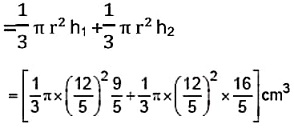Quick actions
Stay organised
Bookmark tricky proofs or add doubts to your dashboard so they resurface before exams.
Open dashboard →NCERT Solutions for Class 10 Maths Chapter 13 – Surface Areas and Volumes
Master "Surface Areas and Volumes" with step-by-step NCERT solutions.
Exercise 13.5
Question 1
. A copper wire, 3 mm in diameter, is wound about a cylinder whose length is 12 cm, and diameter 10 cm, so as to cover the curved surface of the cylinder. Find the length and mass of the wire, assuming the density of copper to be 8.88 g per cm3Answer
Diameter of cylinder = 10 cmRadius of the cylinder r =
 = 5 cm
= 5 cm
∴ Length of wire in one round = 2πr = 2π x 5 cm = 10 π cm
diameter of wire = 3 mm =3/10 = 0.3 cm
∴ The thickness of cylinder = 3/10 m
Hence, the number of turns will be- length of wire required to complete 40 rounds = 40 x 10 π cm = 1257.14 cm
Radius of the wire = cm= 0.15 cm
Volume of wire = Area of cross-section of wire × Length of wire
=π(0.15)2 ×1257.14
= 88.898 cm3
Mass = Volume × Density = 88.898×8.88
= 789.41 gm
= 789.41 gm
Question 2
. A right triangle whose sides are 3 cm and 4 cm (other than hypotenuse) is made to revolve about its hypotenuse. Find the volume and surface area of the double cone so formed. (Choose value of π as found appropriate.)Answer 1

triangle ABC Is right angle triangle so
AB = 4 cm, BC = 3 cm
Hypotenuse BC =
 = 5 cm
= 5 cmArea of triangle ABC=
 x AB x AC
x AB x AC =
 x AC x OB =
x AC x OB =  x 4
x 3
x 4
x 3 x 5
x OB = 6
x 5
x OB = 6OB =
 =2.4 cm
=2.4 cmNow, volume of double cone= Volume of cone 1 + volume of cone

we get,
V = 30.14 cm3
The surface area of the double cone= Surface area of cone 1 + Surface area of cone

= 52.75 cm2
Question 3
. A cistern, internally measuring 150 cm × 120 cm × 100 cm, has 129600 cm3 of water in it. Porous bricks are placed in the water until the cistern is full to the brim. Each brick absorbs one-seventeenth of its own volume of water. How many bricks can be put in without overflowing the water, each being 22.5 cm × 7.5 cm × 6.5 cm?Answer
Dimension of the cistern = 150 × 120 × 110volume of the cistern = 1980000 cm3
Volume to be filled in cistern = 1980000 – 129600 = 1850400 cm3
Let n number of bricks placed in cistern
volume of n bricks will be = n×22.5×7.5×6.5 =1096.875n
each brick absorbs one-seventeenth of its volume,So volume will be
=
 ×(22.5×7.5×6.5)
×(22.5×7.5×6.5)For the condition given in the question,
n×22.5×7.5×6.5 = 1850400 +
 ×(22.5×7.5×6.5)
×(22.5×7.5×6.5)we get,
n = 1792.41
Question 4
In one fortnight of a given month, there was a rainfall of 10 cm in a river valley. If the area of the valley is 7280 km2, show that the total rainfall was approximately equivalent to the addition to the normal water of three rivers each 1072 km long, 75 m wide and 3 m deep.Answer
Rainfall in the rivers= 10cm =0.1mArea of river= 97280km2 =7280000000m2
Volume of water= 7280000000 x 0.1 = 728000000m3
Now, volume of 3 rivers = 3 × 1072000 x 75 x 3 = 3 x 24100000 = 843600000 m3
728000000m3 ≠ 843600000 m3 So, the question statement is false.
Question 5
.. An oil funnel made of tin sheet consists of a 10 cm long cylindrical portion attached to a frustum of a cone. If the total height is 22 cm, diameter of the cylindrical portion is 8 cm and the diameter of the top of the funnel is 18 cm, find the area of the tin sheet required to make the funnel (see Fig.).Answer

Question 6
. Derive the formula for the curved surface area and total surface area of the frustum of a cone, given to you in Section 13.5, using the symbols as explained.Answer

CSA of forstum = π(r1+r2)l The total area of frustum =thel CSA of frustum + the Cover surface area of upper circular end and area of the lower circular end
= π(r1+r2)l+πr22+πr12
∴ Surface area of frustum = π[r1+r2)l+r12+r22]
Question 7
. Derive the formula for the volume of the frustum of a cone.Answer


Chapter shortcuts
- Chapter 1 · Real Numbers
- Chapter 2 · Polynomials
- Chapter 3 · Pair of Linear Equations in Two Variables
- Chapter 4 · Quadratic Equations
- Chapter 5 · Arithmetic Progressions
- Chapter 6 · Triangles
- Chapter 7 · Coordinate Geometry
- Chapter 8 · Introduction to Trigonometry
- Chapter 9 · Some Applications of Trigonometry
- Chapter 10 · Circles
- Chapter 11 · Constructions
- Chapter 12 · Area Related to Circles
- Chapter 13 · Surface Areas and Volumes
- Chapter 14 · Statistics
- Chapter 15 · Probability